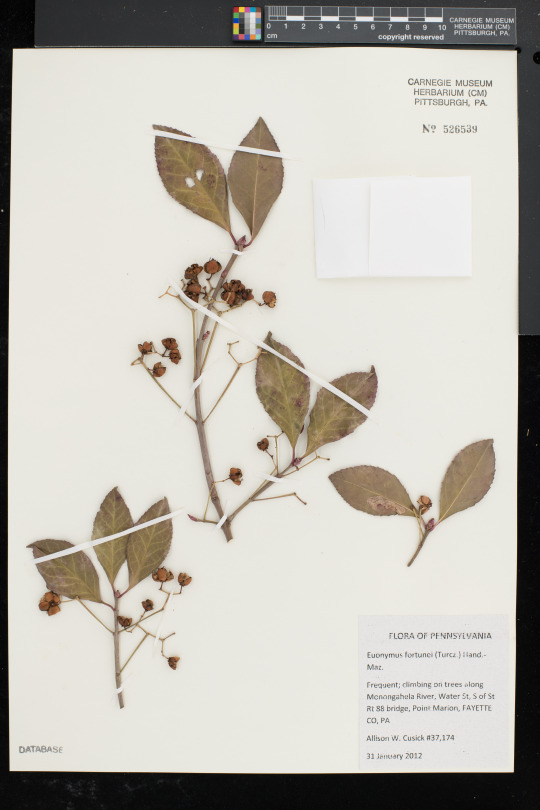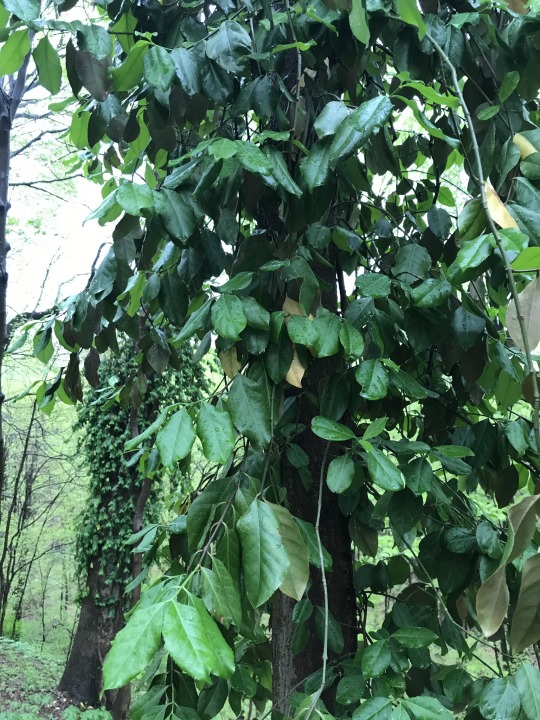
This specimen of wintercreeper (Euonymus fortunei) was collected on January 31, 2012 along the Monongahela River in Fayette County, PA by Alison Cusick. Alison Cusick is a current Research Associate in the Section of Botany at the museum. He can be frequently found in the Carnegie Museum herbarium. He has a unique wealth of knowledge on plants, herbaria, botanical history, and more. He authored three books and more than 50 scientific papers on the flora of eastern North America. Before retiring, he was the Chief Botanist for the Ohio Department of Natural Resources. He continues to collect today, and many thousands of his specimens can found at herbaria across the country.
Note the label on this specimen reads “Cusick, A.W. 37174” The number following a collectors name is known as the…you guessed it… collector number (surprise!). The collector number is the number assigned to a specimen by the collector. It is common for several specimens to have the same collector number, if they are from the same individual or species in the same location on the same day (“duplicate specimens”). Unfortunately, there are no universal rules on how collector numbers are used or assigned. Collector numbers primary use is so the collector and/or others using the specimen can go back to the collector’s field notebook for additional information on the specimen. Collector numbers are different from specimen numbers (which are assigned by the herbarium, such that every specimen has a unique ID for reference). Most collectors number their specimens chronologically in order they were collected (but not always), but some collector numbers consist of dashes and/or letters, too.
Anyway, what I’m getting at is that this specimen (Cusick 37174) suggests Alison has collected AT LEAST over 37,000 specimens. The number is actually higher than that, with duplicates and an additional 8 years of collecting. Not that numbers are everything, but Alison’s contribution to the herbarium record is clearly impressive and impactful.

Ok, now back to the plant! Winter creeper (Euonymus fortunei), native to Asia, is commonly planted in Pennsylvania and many other places, and unfortunately has also spread to become invasive. It is still commonly planted. It is a woody vine that climbs trees, but also is a thick ground cover. It has leaves that persist through the winter, with attractive fruits. Despite those advantages, it can impact native species and habitats as an invasive species, and therefore, should not be planted.
Find this specimen and more here: http://midatlanticherbaria.org/portal/collections/individual/index.php?occid=12134036&clid=0
Check back for more! Botanists at the Carnegie Museum of Natural History share digital specimens from the herbarium on dates they were collected. They are in the midst of a three-year project to digitize nearly 190,000 plant specimens collected in the region, making images and other data publicly available online. This effort is part of the Mid-Atlantic Megalopolis Project (mamdigitization.org), a network of thirteen herbaria spanning the densely populated urban corridor from Washington, D.C. to New York City to achieve a greater understanding of our urban areas, including the unique industrial and environmental history of the greater Pittsburgh region. This project is made possible by the National Science Foundation under grant no. 1801022.
Mason Heberling is Assistant Curator of Botany at the Carnegie Museum of Natural History. Museum employees are encouraged to blog about their unique experiences and knowledge gained from working at the museum.
